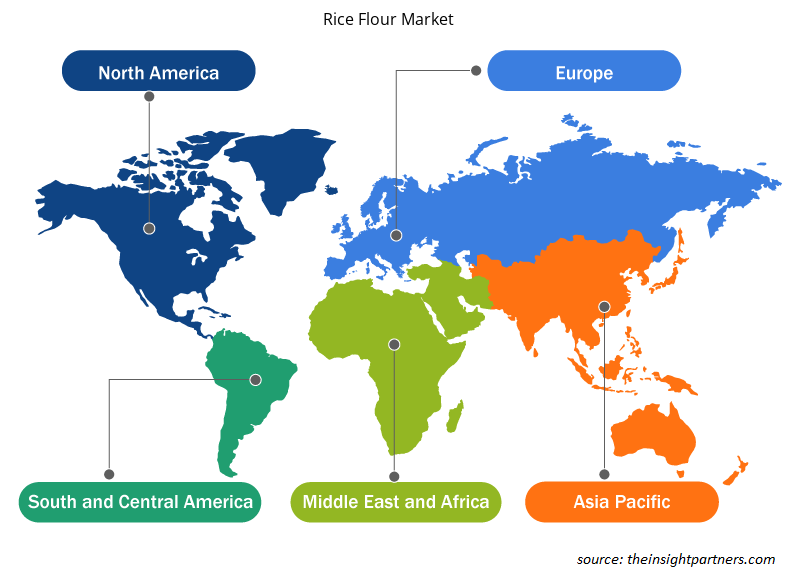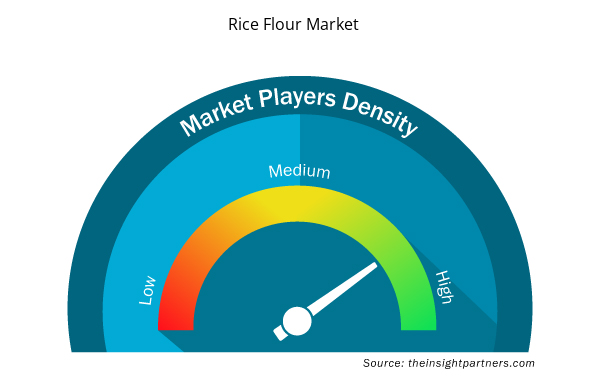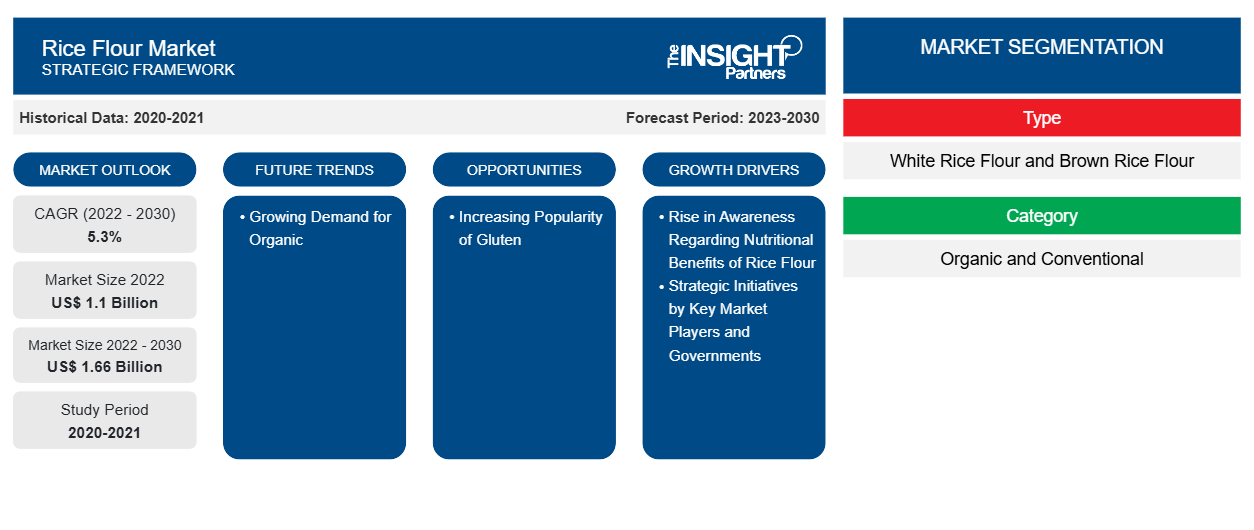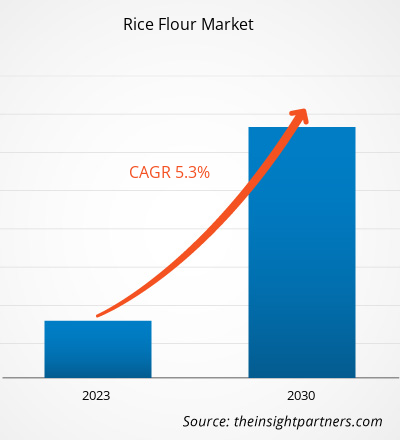[Forschungsbericht] Der Markt für Reismehl hatte im Jahr 2022 einen Wert von 1.100,47 Millionen US-Dollar und soll bis 2030 1.655,82 Millionen US-Dollar erreichen; von 2023 bis 2030 wird eine durchschnittliche jährliche Wachstumsrate (CAGR) von 5,3 % erwartet.
Markteinblicke und Analystenansichten:
Reismehl wird hergestellt, indem die Reiskörner zu grobem oder feinem Pulver gemahlen werden. Reismehl wird als Ersatz für Weizenmehl verwendet, da es kein Gluten enthält. Steigende Gesundheitsbedenken bei den Verbrauchern und die wachsende Nachfrage nach einer glutenfreien Ernährung kurbeln das Wachstum des Reismehlmarktes an . Reismehl bietet verschiedene gesundheitliche Vorteile, darunter eine verbesserte Verdauung, eine verbesserte Skelettgesundheit, eine Unterstützung der Wundheilung und ist vorteilhaft für Zöliakiepatienten. Reismehl ist eine reichhaltige Vitamin-C-Quelle und enthält Antioxidantien, die für die Hautreparatur erforderlich sind. Brauner Reis enthält Vitamin B, einen hohen Proteingehalt und mehr Ballaststoffe und Antioxidantien, während weißer Reis eine reichhaltige Quelle leerer Kalorien ist. Die ernährungsphysiologischen Vorteile von Reis steigern die Nachfrage nach Reismehl bei verschiedenen Lebensmittel- und Getränkeherstellern. Reismehl ist eine gesunde Zutat, die in vielen Lebensmittelprodukten wie Backwaren und Süßwaren, süßen und herzhaften Snacks, Getränken und Babynahrung verwendet wird. Es gibt es in drei Sorten: mittel- und kurzkörnig, langkörnig und vorverkleistert.
Wachstumstreiber und Herausforderungen:
Reismehl ist eine gesunde Zutat, die in vielen Lebensmitteln wie Backwaren und Süßwaren, süßen und herzhaften Snacks, Getränken und Babynahrung verwendet wird. Es gibt drei Sorten: mittel- und kurzkörnig, langkörnig und vorverkleistert. Reismehl ist eine reichhaltige Vitamin-C-Quelle und enthält Antioxidantien, die für die Hautreparatur erforderlich sind. Brauner Reis ist eine Reismehlsorte, die Vitamin B, einen hohen Proteingehalt und mehr Ballaststoffe und Antioxidantien enthält, während weißer Reis eine reichhaltige Quelle leerer Kalorien ist. Die ernährungsphysiologischen Vorteile von Reis steigern die Nachfrage nach Reismehl bei verschiedenen Lebensmittel- und Getränkeherstellern. Cholin, ein essentieller Nährstoff für Tiere und Menschen, ist in Reismehl enthalten. Es hilft beim Transport von Cholesterin und Triglyceriden von der Leber in den Körper. Daher wird es mit der Unterstützung der Lebergesundheit in Verbindung gebracht. Reismehl ist reich an Kalzium – 10 mg pro 100 g Reismehl helfen, die Knochen gesund zu halten. In Kombination mit anderen kalziumreichen Lebensmitteln wie Milch, Käse, Tofu und Nüssen hilft es, die empfohlene Tagesdosis einzuhalten. Der Markt wird daher durch das zunehmende Bewusstsein der Verbraucher hinsichtlich der ernährungsphysiologischen Vorteile von Reismehl angetrieben.
Reismehl ist die wichtigste Zutat und Ware zur Herstellung verschiedener Lebensmittel und Getränke. Jede Unterbrechung der Lieferkette von Rohstoffen wie Reis erhöht letztendlich die Reismehlpreise. Angebotsschwankungen können durch verschiedene Faktoren verursacht werden, von Wetter, Pflanzenkrankheiten und Schädlingen bis hin zu politischen und sozialen Unruhen und Arbeitskräftemangel. Außerdem stellen Hersteller Reismehl her, indem sie Langkornreis zu unangemessenen Preisen mahlen, um die steigende Nachfrage zu befriedigen. Diese Faktoren führen zu massiven Preiserhöhungen. Eine der größten Herausforderungen auf dem Reismehlmarkt ist die Unberechenbarkeit der Getreidepreise aufgrund des Klimawandels. Klimavariabilität und saisonale Schwankungen haben große Auswirkungen auf Pflanzen, verringern die Ernteerträge an verschiedenen Standorten und führen letztendlich zu Input- und Preisunterschieden in der Produktion. Beispielsweise behindern lange Trockenperioden den Reisanbau. Darüber hinaus werden Schwankungen der Erntepreise durch variable Energie-, Chemikalien- und Düngemittelkosten verursacht. Die Volatilität der Reispreise ist nichts Neues, da die Rohstoffpreise häufig schwanken. Allerdings könnte die derzeit steigende Nachfrage nach Reis in Verbindung mit Unterbrechungen oder unzureichenden Reislieferungen dramatische Auswirkungen auf den Reismehlpreis haben und somit das Marktwachstum behindern.
Passen Sie diesen Bericht Ihren Anforderungen an
Sie erhalten kostenlos individuelle Anpassungen an jedem Bericht, einschließlich Teilen dieses Berichts oder einer Analyse auf Länderebene, eines Excel-Datenpakets sowie tolle Angebote und Rabatte für Start-ups und Universitäten.
- Holen Sie sich die wichtigsten Markttrends aus diesem Bericht.Dieses KOSTENLOSE Beispiel umfasst eine Datenanalyse von Markttrends bis hin zu Schätzungen und Prognosen.
Berichtssegmentierung und -umfang:
Der globale Reismehlmarkt ist nach Typ, Kategorie, Anwendung und Geografie segmentiert. Der Reismehlmarkt ist je nach Typ in Weißreismehl und Braunreismehl segmentiert. Der Reismehlmarkt ist je nach Kategorie in Bio und konventionell kategorisiert. Je nach Anwendung ist der Markt in Backwaren und Süßwaren, Getränke, süße und herzhafte Snacks, Babynahrung, Frühstückszerealien und andere segmentiert. Der globale Reismehlmarkt ist grob nach Geografie segmentiert in Nordamerika, Europa, Asien-Pazifik, Naher Osten und Afrika sowie Süd- und Mittelamerika.
Segmentanalyse:
Der Reismehlmarkt ist nach Art in Weißreismehl und Braunreismehl unterteilt. Das Braunreismehlsegment wird im Prognosezeitraum voraussichtlich eine höhere durchschnittliche jährliche Wachstumsrate verzeichnen. Im Gegensatz zu Weißreismehl wird Braunreismehl aus Vollkorn-Naturreis hergestellt, wobei Kleie und Keimschicht erhalten bleiben. Daher enthält Braunreismehl mehr Ballaststoffe, Vitamine, Mineralien und Antioxidantien als Weißreismehl. Das gestiegene Bewusstsein für die ernährungsphysiologischen Vorteile von Vollkorn und der Wunsch nach gesünderen Nahrungsmitteln treiben die Nachfrage nach Braunreismehl an. Braunreis ist von Natur aus glutenfrei und kann als Alternative zu Weizenmehl zum glutenfreien Backen und Kochen verwendet werden. Darüber hinaus besteht ein wachsendes Interesse an Vollwertkost und minimal verarbeiteten Zutaten als Teil eines gesunden Lebensstils. Braunreismehl, ein Vollkornprodukt, folgt diesem Trend und Verbraucher bevorzugen es möglicherweise als nahrhaftere Alternative zu raffiniertem Mehl. Außerdem ist Braunreismehl frei von üblichen Allergenen wie Weizen, Soja, Milchprodukten und Nüssen. Dadurch ist es für Personen mit mehreren Nahrungsmittelallergien oder -empfindlichkeiten geeignet. Darüber hinaus kann braunes Reismehl in verschiedenen kulinarischen Anwendungen verwendet werden, darunter in der Bäckerei, beim Kochen und zum Andicken von Soßen. Es kann Rezepten einen nussigen Geschmack und eine dichtere Textur verleihen und so das Geschmacksprofil von Gerichten verbessern. All diese Faktoren fördern das Wachstum des Marktes für braunes Reismehl.
Regionale Analyse:
Geografisch ist der Reismehlmarkt in fünf Hauptregionen unterteilt: Nordamerika, Europa, Asien-Pazifik, Süd- und Mittelamerika sowie Naher Osten und Afrika. Der globale Reismehlmarkt wurde vom Asien-Pazifik-Raum dominiert, der im Jahr 2022 435,44 Millionen US-Dollar ausmachte. Nordamerika ist ein zweiter großer Beitragszahler mit einem Anteil von mehr als 28 % am Weltmarkt. Es wird erwartet, dass Nordamerika im Prognosezeitraum ebenfalls ein beträchtliches Wachstum mit einer durchschnittlichen jährlichen Wachstumsrate von über 6 % verzeichnen wird. Nordamerika ist eine der bedeutendsten Regionen, die aus starken und entwickelten Volkswirtschaften wie den USA, Kanada und Mexiko besteht. Die Bäckereiindustrie ist eine der bedeutendsten Branchen in Nordamerika, da Backwaren als Grundnahrungsmittel gelten. Laut der American Bakers Association hat die Bäckereiindustrie in den USA einen durchschnittlichen Jahresumsatz von 154 Milliarden US-Dollar. Aufgrund eines hektischen Lebensstils und einer zunehmenden Vorliebe für Fertiggerichte steigt auch die Nachfrage nach Keksen, Kuchen, Gebäck, Muffins und anderen Backwaren. Da die Backwarenindustrie zu den größten Endverbrauchern von Reismehl gehört, wird erwartet, dass der Markt für Reismehl in den kommenden Jahren wachsen wird.
Branchenentwicklungen und zukünftige Chancen:
Nachfolgend sind verschiedene Initiativen der wichtigsten Akteure auf dem Markt für künstliche Wimpern aufgeführt:
- Im April 2023 ging das südkoreanische Ministerium für Landwirtschaft, Ernährung und ländliche Angelegenheiten (MAFRA) den nächsten Schritt seines nationalen „Reisproduktentwicklungsprojekts“ und arbeitete mit 15 großen lokalen Lebensmittel- und Getränkeunternehmen zusammen. Das Ministerium gab seine Pläne bekannt, in diesem Jahr 19 neue Produkte auf Reisbasis zu entwickeln.
Regionale Einblicke in den Reismehlmarkt
Die regionalen Trends und Faktoren, die den Reismehlmarkt im Prognosezeitraum beeinflussen, wurden von den Analysten von Insight Partners ausführlich erläutert. In diesem Abschnitt werden auch die Marktsegmente und die Geografie des Reismehlmarkts in Nordamerika, Europa, im asiatisch-pazifischen Raum, im Nahen Osten und Afrika sowie in Süd- und Mittelamerika erörtert.

- Holen Sie sich die regionalen Daten für den Reismehlmarkt
Umfang des Marktberichts über Reismehl
| Berichtsattribut | Details |
|---|---|
| Marktgröße im Jahr 2022 | 1,1 Milliarden US-Dollar |
| Marktgröße bis 2030 | 1,66 Milliarden US-Dollar |
| Globale CAGR (2022 - 2030) | 5,3 % |
| Historische Daten | 2020-2021 |
| Prognosezeitraum | 2023–2030 |
| Abgedeckte Segmente | Nach Typ
|
| Abgedeckte Regionen und Länder | Nordamerika
|
| Marktführer und wichtige Unternehmensprofile |
|
Dichte der Marktteilnehmer auf dem Reismehlmarkt: Die Auswirkungen auf die Geschäftsdynamik verstehen
Der Markt für Reismehl wächst rasant, angetrieben durch die steigende Nachfrage der Endverbraucher aufgrund von Faktoren wie sich entwickelnden Verbraucherpräferenzen, technologischen Fortschritten und einem größeren Bewusstsein für die Vorteile des Produkts. Mit steigender Nachfrage erweitern Unternehmen ihr Angebot, entwickeln Innovationen, um die Bedürfnisse der Verbraucher zu erfüllen, und nutzen neue Trends, was das Marktwachstum weiter ankurbelt.
Die Marktteilnehmerdichte bezieht sich auf die Verteilung der Firmen oder Unternehmen, die in einem bestimmten Markt oder einer bestimmten Branche tätig sind. Sie gibt an, wie viele Wettbewerber (Marktteilnehmer) in einem bestimmten Marktraum im Verhältnis zu seiner Größe oder seinem gesamten Marktwert präsent sind.
Die wichtigsten auf dem Reismehlmarkt tätigen Unternehmen sind:
- PGP International Inc
- Ebro Foods SA
- Western Foods LLC
- Ingredion Inc
- CAREMOLI SpA
Haftungsausschluss : Die oben aufgeführten Unternehmen sind nicht in einer bestimmten Reihenfolge aufgeführt.

- Überblick über die wichtigsten Akteure auf dem Reismehlmarkt
Auswirkungen von Covid-19:
Die COVID-19-Pandemie wirkte sich zunächst auf den globalen Reismehlmarkt aus, da Produktionsstätten geschlossen wurden, Arbeitskräftemangel herrschte, Lieferketten unterbrochen wurden und finanzielle Instabilität herrschte. Die Unterbrechung verschiedener Branchen aufgrund der durch den COVID-19-Ausbruch verursachten Konjunkturabschwächung bremste die Nachfrage nach Reismehl. Die Unternehmen gewinnen jedoch an Boden, da zuvor verhängte Beschränkungen in mehreren Ländern gelockert wurden. Darüber hinaus entspannte die Einführung von COVID-19-Impfstoffen durch Regierungen verschiedener Länder die Situation und führte zu einem Anstieg der Geschäftsaktivitäten weltweit. Mehrere Märkte verzeichneten nach der Lockerung der Ausgangssperren und Bewegungseinschränkungen ein Wachstum, darunter auch der Reismehlmarkt.
Wettbewerbslandschaft und Schlüsselunternehmen:
Zu den führenden Akteuren auf dem globalen Markt für falsche Wimpern zählen unter anderem PGP International Inc, Ebro Foods SA, Western Foods LLC, Ingredion Inc, CAREMOLI SpA, BELOURTHE SA, Kroner-Starke GmbH, Capitol Food Co, Ardent Mills LLC, Bay State Milling Co, Bob's Red Mill Natural Foods Inc, Gulf Pacific Rice Co Inc, Naturis SpA, Hometown Food Co, Koda Farms Inc und Archer-Daniels-Midland Co.
- Historische Analyse (2 Jahre), Basisjahr, Prognose (7 Jahre) mit CAGR
- PEST- und SWOT-Analyse
- Marktgröße Wert/Volumen – Global, Regional, Land
- Branche und Wettbewerbsumfeld
- Excel-Datensatz



Report Coverage
Revenue forecast, Company Analysis, Industry landscape, Growth factors, and Trends

Segment Covered
This text is related
to segments covered.

Regional Scope
North America, Europe, Asia Pacific, Middle East & Africa, South & Central America

Country Scope
This text is related
to country scope.
Häufig gestellte Fragen
Rice flour is a healthy ingredient used in many food products such as bakery and confectionery, sweet and savory snacks, beverages, and baby foods. It comes in three varieties—medium & short grain, long grain, and pre-gelatinized. Rice flour is high in vitamin C and rich in antioxidants required for skin repair. Based on type, the rice flour market is bifurcated into white rice and brown rice. Brown rice contains vitamin B, high protein content, and more fiber and antioxidants, whereas white rice is a rich source of empty calories. The nutritional benefits of sourced rice boost the demand for rice flour among various food & beverage manufacturers. Choline, an essential nutrient for animals and humans, is found in rice flour. It aids in transporting cholesterol and triglycerides from the liver to the body. As a result, it has been linked to supporting liver health. Rice flour is rich in calcium content—10 mg in every 100 g of rice flour helps keep bones healthy. Incorporating rice flour in food and beverages aids in maintaining human health. It helps maintain daily recommended intake levels when combined with other calcium-rich food, such as milk, cheese, tofu, and nuts. Hence, the increasing awareness regarding the nutritional benefits of rice flour among consumers is driving the market.
In 2022, Asia Pacific region accounted for the largest share of the global rice flour market. The Asia Pacific rice flour market is segmented into China, India, Australia, Japan, South Korea, and the Rest of Asia Pacific. The growing influence of Western culture on consumers is influencing their food consumption habits. The young population consumes breakfast and quick meals in the form of bread, cookies, biscuits, pancakes, and other bakery products. Further, the demand for gluten-free bakery products is increasing as consumers are increasingly becoming health-conscious. Thus, the demand for rice flour is growing as it acts as a substitute.
The major players operating in the global rice flour market are PGP International Inc, Ebro Foods SA, Western Foods LLC, Ingredion Inc, CAREMOLI SpA, BELOURTHE SA, Kroner-Starke GmbH, Capitol Food Co, Ardent Mills LLC, Bay State Milling Co, Bob's Red Mill Natural Foods Inc, Gulf Pacific Rice Co Inc, Naturis SpA, Hometown Food Co, Koda Farms Inc, Archer-Daniels-Midland Co, among others.
Organic and Fairtrade-certified rice flour has been witnessing strong demand in the global market owing to consumer inclination toward safer and healthier products that help maintain overall health. Further, there has been an abrupt increase in sales of rice flour that are both fairtrade and organic-certified. The rising preference for pesticide-free food products positively affects the demand for organically grown rice commodities.
The increasing popularity and acceptance of organic rice flour is one of the significant trends in the global market. Organic rice flour is made from organically grown rice cultivated as per the rules & guidelines provided by the authorized organizations. Organic rice is cultivated without chemicals, pesticides, synthetic fertilizers, or other harmful agents. An increase in consumer awareness about organic products and strong public support for developing natural and nutritionally rich products are driving the demand for organically grown rice. Further, the demand for organic rice flour is increasing among various application industries such as bakery & confectionery, sweet & savory products, beverages, and baby food. Thus, the escalating demand for organic rice flour is expected to positively influence the rice flour market growth during the forecast period.
Based on the category, the organic segment is predicted to register a higher CAGR during the forecast period. Organic rice flour refers to rice flour that is produced from organically grown rice. Organic rice flour is free from synthetic fertilizers, pesticides, and other potentially harmful chemicals that may be used in conventional rice farming. Consumers concerned about chemical residues in their food may choose organic rice flour as a safer and more natural option. Also, some believe that organic foods, including organic rice flour, may offer greater nutritional value and health benefits than conventionally grown counterparts. Moreover, organic rice flour is certified according to specific organic standards and regulations. This certification ensures the consumers that the product meets the established criteria for organic production. These factors are surging the demand for organic rice flour.
Based on the type, the brown rice flour segment is expected to register the highest CAGR during the forecast period. Unlike white rice flour, brown rice flour is made from whole-grain brown rice, retaining the bran and germ layers. As a result, brown rice flour contains higher levels of fibers, vitamins, minerals, and antioxidants than white rice flour. Increased awareness about the nutritional benefits of whole grains and the desire for healthier food options drive the demand for brown rice flour. Brown rice is naturally gluten-free and can be used in gluten-free baking and cooking as an alternative to wheat flour.
Additionally, there has been a growing interest in whole foods and minimally processed ingredients as part of a healthy lifestyle. Brown rice flour, a whole grain product, aligns with this trend, and consumers may prefer it as a more nutritious option than refined flour. Also, brown rice flour is free from common allergens such as wheat, soy, dairy, and nuts. This makes it suitable for individuals with multiple food allergies or sensitivities. Furthermore, brown rice flour can be used in various culinary applications, including bakery, cooking, and thickening sauces. It can add a nutty flavor and a denser texture to recipes, enhancing the taste profile of dishes. All these factors are bolstering the brown rice flour market growth.
Trends and growth analysis reports related to Food and Beverages : READ MORE..
The List of Companies - Rice Flour Market
- PGP International Inc
- Ebro Foods SA
- Western Foods LLC
- Ingredion Inc
- CAREMOLI SpA
- BELOURTHE SA
- Kroner-Starke GmbH
- Capitol Food Co
- Ardent Mills LLC
- Bay State Milling Co
- Bob's Red Mill Natural Foods Inc
- Gulf Pacific Rice Co Inc,
- Naturis SpA
- Hometown Food Co
- Koda Farms Inc
- Archer-Daniels-Midland Co
The Insight Partners performs research in 4 major stages: Data Collection & Secondary Research, Primary Research, Data Analysis and Data Triangulation & Final Review.
- Data Collection and Secondary Research:
As a market research and consulting firm operating from a decade, we have published and advised several client across the globe. First step for any study will start with an assessment of currently available data and insights from existing reports. Further, historical and current market information is collected from Investor Presentations, Annual Reports, SEC Filings, etc., and other information related to company’s performance and market positioning are gathered from Paid Databases (Factiva, Hoovers, and Reuters) and various other publications available in public domain.
Several associations trade associates, technical forums, institutes, societies and organization are accessed to gain technical as well as market related insights through their publications such as research papers, blogs and press releases related to the studies are referred to get cues about the market. Further, white papers, journals, magazines, and other news articles published in last 3 years are scrutinized and analyzed to understand the current market trends.
- Primary Research:
The primarily interview analysis comprise of data obtained from industry participants interview and answers to survey questions gathered by in-house primary team.
For primary research, interviews are conducted with industry experts/CEOs/Marketing Managers/VPs/Subject Matter Experts from both demand and supply side to get a 360-degree view of the market. The primary team conducts several interviews based on the complexity of the markets to understand the various market trends and dynamics which makes research more credible and precise.
A typical research interview fulfils the following functions:
- Provides first-hand information on the market size, market trends, growth trends, competitive landscape, and outlook
- Validates and strengthens in-house secondary research findings
- Develops the analysis team’s expertise and market understanding
Primary research involves email interactions and telephone interviews for each market, category, segment, and sub-segment across geographies. The participants who typically take part in such a process include, but are not limited to:
- Industry participants: VPs, business development managers, market intelligence managers and national sales managers
- Outside experts: Valuation experts, research analysts and key opinion leaders specializing in the electronics and semiconductor industry.
Below is the breakup of our primary respondents by company, designation, and region:

Once we receive the confirmation from primary research sources or primary respondents, we finalize the base year market estimation and forecast the data as per the macroeconomic and microeconomic factors assessed during data collection.
- Data Analysis:
Once data is validated through both secondary as well as primary respondents, we finalize the market estimations by hypothesis formulation and factor analysis at regional and country level.
- Macro-Economic Factor Analysis:
We analyse macroeconomic indicators such the gross domestic product (GDP), increase in the demand for goods and services across industries, technological advancement, regional economic growth, governmental policies, the influence of COVID-19, PEST analysis, and other aspects. This analysis aids in setting benchmarks for various nations/regions and approximating market splits. Additionally, the general trend of the aforementioned components aid in determining the market's development possibilities.
- Country Level Data:
Various factors that are especially aligned to the country are taken into account to determine the market size for a certain area and country, including the presence of vendors, such as headquarters and offices, the country's GDP, demand patterns, and industry growth. To comprehend the market dynamics for the nation, a number of growth variables, inhibitors, application areas, and current market trends are researched. The aforementioned elements aid in determining the country's overall market's growth potential.
- Company Profile:
The “Table of Contents” is formulated by listing and analyzing more than 25 - 30 companies operating in the market ecosystem across geographies. However, we profile only 10 companies as a standard practice in our syndicate reports. These 10 companies comprise leading, emerging, and regional players. Nonetheless, our analysis is not restricted to the 10 listed companies, we also analyze other companies present in the market to develop a holistic view and understand the prevailing trends. The “Company Profiles” section in the report covers key facts, business description, products & services, financial information, SWOT analysis, and key developments. The financial information presented is extracted from the annual reports and official documents of the publicly listed companies. Upon collecting the information for the sections of respective companies, we verify them via various primary sources and then compile the data in respective company profiles. The company level information helps us in deriving the base number as well as in forecasting the market size.
- Developing Base Number:
Aggregation of sales statistics (2020-2022) and macro-economic factor, and other secondary and primary research insights are utilized to arrive at base number and related market shares for 2022. The data gaps are identified in this step and relevant market data is analyzed, collected from paid primary interviews or databases. On finalizing the base year market size, forecasts are developed on the basis of macro-economic, industry and market growth factors and company level analysis.
- Data Triangulation and Final Review:
The market findings and base year market size calculations are validated from supply as well as demand side. Demand side validations are based on macro-economic factor analysis and benchmarks for respective regions and countries. In case of supply side validations, revenues of major companies are estimated (in case not available) based on industry benchmark, approximate number of employees, product portfolio, and primary interviews revenues are gathered. Further revenue from target product/service segment is assessed to avoid overshooting of market statistics. In case of heavy deviations between supply and demand side values, all thes steps are repeated to achieve synchronization.
We follow an iterative model, wherein we share our research findings with Subject Matter Experts (SME’s) and Key Opinion Leaders (KOLs) until consensus view of the market is not formulated – this model negates any drastic deviation in the opinions of experts. Only validated and universally acceptable research findings are quoted in our reports.
We have important check points that we use to validate our research findings – which we call – data triangulation, where we validate the information, we generate from secondary sources with primary interviews and then we re-validate with our internal data bases and Subject matter experts. This comprehensive model enables us to deliver high quality, reliable data in shortest possible time.


 Holen Sie sich ein kostenloses Muster für diesen Bericht
Holen Sie sich ein kostenloses Muster für diesen Bericht